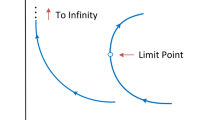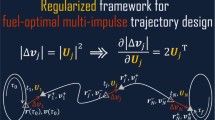Abstract
Air drag B∗ factors from Earth satellite element sets often show the characteristic near Gaussian distribution and autocorrelation exponential decay typical of a Gauss-Markov process. Assuming the “most current” set of orbital elements are correct, earlier elements can be used to construct covariance matrices as a function of prediction time into the future. If resolved in cylindrical orbit frame coordinates, these are remarkably structured, essentially showing only in-track error growth. Often the in-track position covariance element growth follows a fourth power in time rule, and is definitely forced by the uncertainty in the air drag factor. This observation is confirmed both by perturbation theory and by modeling stochastic state covariance propagation. Realizing that almost all error growth under the SGP4 model is in track, the Cosmos 2251/Iridium 33 event is reexamined. While a collision prediction from the last elements shows a minimum miss distance of about 700 m, those same elements show a closest approach distance of the orbits of only 32 m. Given large in-track uncertainty, minimum orbit separation may be a much more reliable metric for maneuver decisions.







Similar content being viewed by others
References
Peterson, G., Gist, R. G., Oltrogge, D. I.: Covariance generation for space objects using public data. Adv. Astronaut. Sci. 108, 201–214 (2001)
Kelso, T. S.: Validation of SGP4 and IS-GPS-200D against GPS precision ephemerides. Adv. Astronaut. Sci. 127, 427–440 (2007)
Osweiler, V. P.: Covariance estimation and autocorrelation of NORAD two-line element sets. Master’s thesis, Air Force Institute of Technology (2006)
Geul, J., Mooij, E., Noomen, R.: TLE uncertainty estimation using robust weighted differencing. Adv. Space Res. 59, 2522–2535 (2017). https://doi.org/10.1016/j.asr.2017.02.038
Jacchia, L. G.: Thermospheric temperature, density, and composition: new models. Smithsonian Astrophysical Observatory Special Reports no. 375 (1977)
Storz, M., Bowman, B., Branson, J. I., Casali, S. J., Tobiska, W. K.: High Accuracy Satellite Drag Model (HASDM). Adv. Space Res. 12, 2497–2505 (2005)
Emmert, J. T.: Thermospheric mass density: a review. Adv. Space Res. 56, 773–824 (2015). https://doi.org/10.1016/j.asr.2015.05.038
Picone, J., Emmert, J., Lean, J.: Thermospheric densities derived from spacecraft orbits: accurate processing of two-line element sets. J. Geophys. Res. 110, 19 (2005). https://doi.org/10.1029/2004JA010585 https://doi.org/10.1029/2004JA010585
Doornbos, E., Klinkrad, H., Visser, P.: Use of two-line element data for thermosphere neutral density model calibration. Adv. Space Res. 41, 1115–1122 (2008)
Jizhang Sang, J. C. B., Smith, C. H.: Estimation of ballistic coefficients of low altitude debris objects from historical two line elements. Adv. Space Res. 52, 117–124 (2013). https://doi.org/10.1016/j.asr.2013.03.010 https://doi.org/10.1016/j.asr.2013.03.010
Gelb, A, et al.: Applied Optimal Estimation. MIT Press, Cambridge (1974)
Space-Track.org: Space Situational Awareness. https://www.space-track.org/auth/login (2016)
Vallado, D., Crawford, P., Hujsak, R., Kelso, T.: Revisiting Spacetrack Report No.3. 2006 AIAA/AAS Astrodynamics Specialist Conference No. AIAA 2006-6753, AIAA (2006)
Wiesel, WE: Modern Orbit Determination. Create Space (2010)
Regan, F. J., Anandakrishnan, S. M.: Dynamics of atmospheric re-entry. AIAA Education Series (1993)
Kessler, D. J., Cour-Palais, B. G.: Collision frequency of artificial satellites: the creation of a debris belt. J. Geophys. Res. 83, 2637–2646 (1978)
Kelso, T. S.: Analysis of the Iridium 33-Cosmos 2251 Collision. http://celestrak.com/events/collision/ (2009)
Acknowledgments
The authors gratefully acknowledges the support of the Air Force Research Laboratory/RV. Portions of this work appear in, or were inspired by the Master’s research of the first two authors.
Author information
Authors and Affiliations
Corresponding author
Rights and permissions
About this article
Cite this article
Rich, A.T., Stuart, K.J. & Wiesel, W.E. Stochastic Dynamics of and Collision Prediction for Low Altitude Earth Satellites. J of Astronaut Sci 65, 307–320 (2018). https://doi.org/10.1007/s40295-018-0129-9
Published:
Issue Date:
DOI: https://doi.org/10.1007/s40295-018-0129-9




